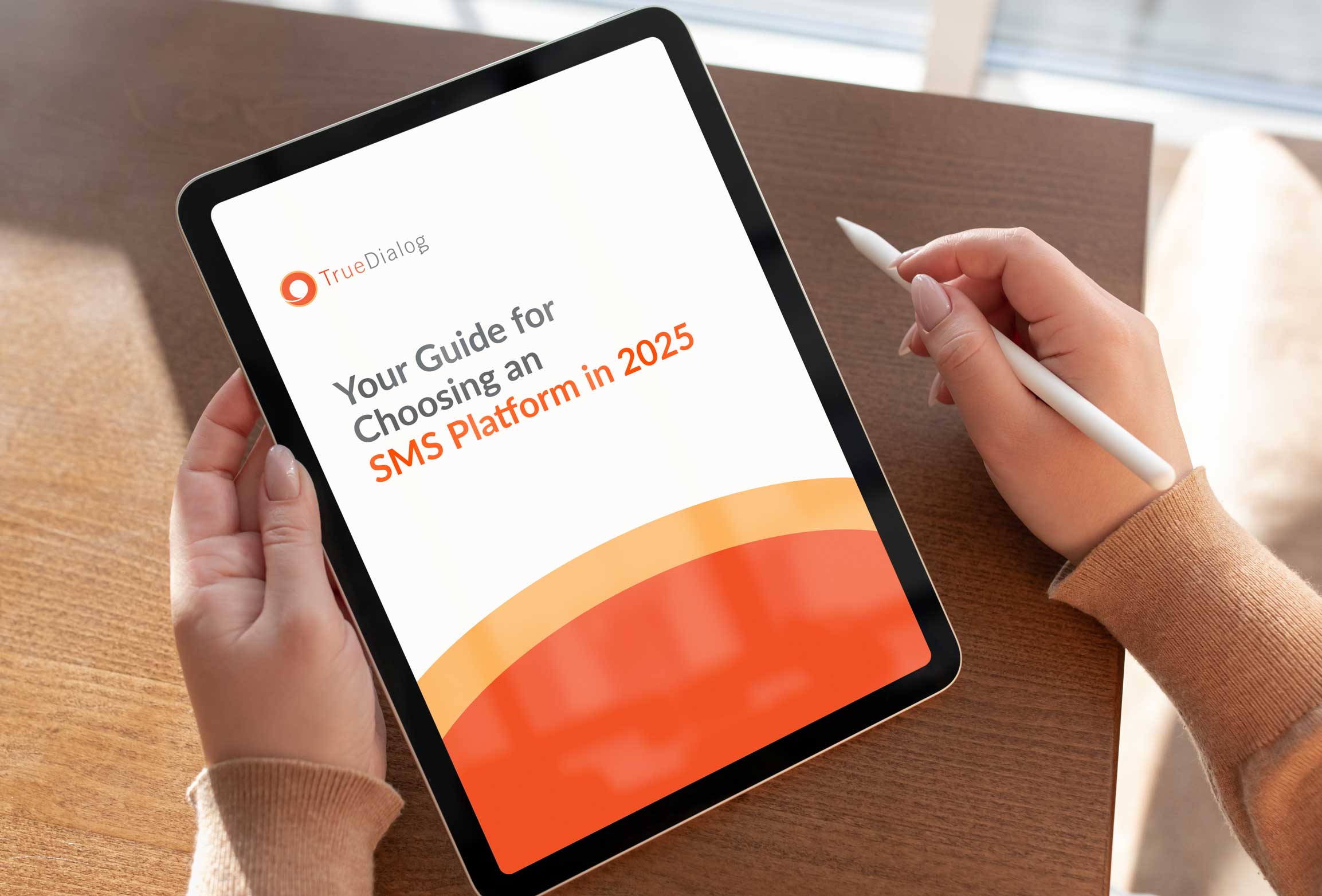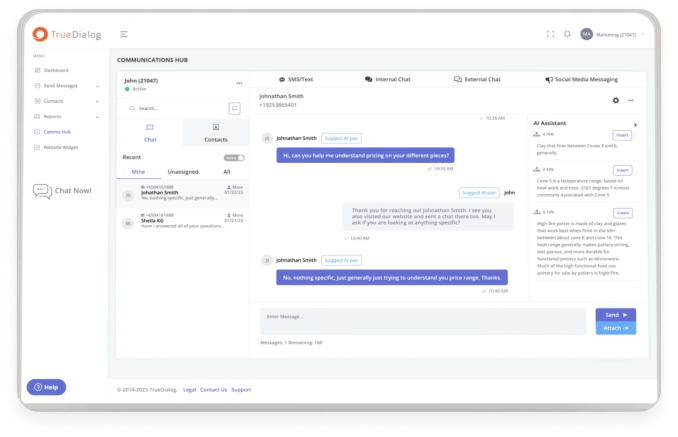By now you may have caught on that text messaging is a school’s best friend. Mail isn’t timely, emails get buried, and bulletin boards on campus get missed – particularly with classes moving to online or hybrid environments.
Text is the most effective way to reach students, faculty, and relatives. SMS has a 98% open rate, and 60% of people read texts within 1-5 minutes of receipt. If you’re still hoping your emails will make it to your students in time, you’re taking a big chance.
Whether you’re already texting students or you’re just starting out, we have some best practices that will help ensure you’re effective in your communication. By keeping a few things in mind, you’ll be sure to reach more of your students, have engaging conversations, streamline your processes, and see better results.
Uses for Text Messaging
The Enrollment Process
Related: Using a College SMS System to Boost University Enrollment
Appointment, Deadline, and Event Reminders
Another great and valuable use for SMS is sending reminders to recipients. Not only does this help keep prospective and current students organized, but it helps ensure commitments are kept.
Staff in departments like recruitment, enrollment, and financial aid is limited. Having a no-show to a meeting with one of these departments means someone else has missed out on an opportunity to discuss important information. Sending a reminder a couple of days ahead of an appointment will also give your recipient an opportunity to reschedule.
There are some crucial deadlines for students in higher education. When it comes to providing paperwork, submitting applications, completing financial aid processes, and more, time is of the essence. Send reminders of these important dates to help recipients stay on track.
Those aren’t the only deadlines that can benefit from texts. Consider assignment due dates, midterm schedules, and other key – and crucial – moments in their student life.
You can also send reminders about events and increase your attendance rate. Campus tours, key sports competitions, and other events can sometimes slip people’s minds. Send a small reminder of the day, time, and place to attend these events and you’ll see a better turnout.
Share Content and Invitations
Hosted a campus tour and now you’d like to send more information? Use text messaging to send links to documents or packages of information to follow up on your tour. Not limited to supplying valuable information, you’ll also have a reason to reach out to prospective students, helping you stay front of mind.
Sending invitations is also a great use for SMS. That includes inviting prospective or current students, or even their family members who have registered to receive communication from you.
Urgent Alerts
If the last year and a half have taught us something, it’s that change can happen rapidly and unexpectedly. It has also shown us how quickly information can become outdated, or needs to be updated and received by those affected in nearly real-time.
Of course, we’re all hoping the need for pandemic updates and restrictions becomes a thing of the past – and soon. But changes in classes that come into play related to waves of illness aren’t the only urgencies you may need to communicate about.
Use SMS to alert about weather-related closures, electricity or internet outages, major traffic events that may affect those who live off-campus or security concerns. There is no better way to get these time-sensitive messages out to those who need to see them.
Related: How to Use a College Urgent Notification System to Stay Engaged with Your People During a Crisis
Two-Way Communication
While it’s obviously not the same as chatting with your friends, SMS within the higher education context offers some similarities. You don’t need to purely send outgoing messages, you can also receive responses.
Initiate conversations about the application, approval, or financial aid process. Solicit feedback from those who have recently attended or appeared at your school. Book or reschedule appointments. Offer general support for those with questions or concerns.
You don’t want this to turn into a lengthy and detailed interaction – there are better avenues for that, like email or portal messages, particularly when resolving issues. But your students will be happy you are available and can offer a response to direct them where they need to go.
How to Maximize Your Text Communication Strategy
So now that it’s clear how many ways you can use SMS to reach out to your prospective and current students, it’s best to understand just how to go about doing that. Sending a text as the voice of a business – or in your case, a school – is much different than sending casual messages to family members.
By adopting some easy yet crucial best practices you’ll ensure that your school is well-represented in your communications and that you deliver value for best results.
Find Your Voice
Finding your voice of course comes naturally in personal messages. After all, you’re the only one sending them to friends and family and your own personality and relationship dynamic makes it clear how and what you’ll say.
When it comes to sending text messages from your higher education institution, finding your voice is more of a deliberate effort. You’ll likely have a team working on a strategy or different people and departments taking ownership of communications depending on the context.
Take some time to be clear about the tone and voice you’d like to use on behalf of your institution so that it’s clear to everyone. Decide on a clear and consistent tone that you’ll use across your messages. If you are too formal, communications will feel cold and robotic. Too casual and you risk losing credibility.
Finding your voice defines the personality of the messages that are sent on behalf of your school. Are you going to be casual, fun, and laden with emojis? Or have firm boundaries and formal speech to make a clear line through your tone? Whatever you decide, be clear and consistent.
Use Clear Abbreviations
Text messages aren’t emails. That sounds obvious, of course, but it’s worth being said. Where you may be leveraging SMS for digital marketing purposes, you can’t expect to drop the same information into a text inbox.
Texts should be clear, succinct, and actionable. You’ll need to stick to 160 characters or less and at first, that will take some practice. To save some space, you can leverage common and clear abbreviations. Not outdated and overly casual ones like “u” instead of “you”. There are others, though, that can work in your favor.
btw – by the way
info – information
fyi – for your information
lmk – let me know
reg – registration/register
qs/?s – questions
fin aid – financial aid
app – application
Don’t risk a message that looks like hieroglyphs by overusing abbreviations. Use them sparingly but strategically.
Take a Proactive Approach
You can add a lot of value to your students’ experience with your school by being proactive in your messaging. While it may be helpful to be reactive and to follow up on missed deadlines, it’s crucial to begin with a proactive approach.
Consider an impending application deadline. Rather than waiting to alert prospective or current students that they missed the deadline and offering them a final chance, be proactive. Send a short-and-sweet message reminding them of the due date.
Rather than alerting a student that they won’t be in their chosen course next semester because their payment hasn’t been made, encourage them to confirm their payment after they’ve enrolled. Students will be grateful that you’re on their side when life gets busy.
Set the Tone
The first message you send sets the tone for all of your further interactions. Much like a first impression, it’s great to consider how you show up and introduce yourself.
Sending a warm and welcoming message is a great start. Include an introduction to your institution as well as your name and your role there. Let them know why you’ll be texting, and give them an opportunity to opt out. The FCC requires that you give subscribers an easy opt-out option, so make sure you are clear about how they can make this choice.
Send a Nudge
An easy and friendly way to communicate with your contacts is to send a nudge. Sometimes you will nudge them to remind them of commitments, such as an upcoming event they previously RSVP’d for. Sometimes your brief nudge will alert them to something they didn’t even know they had to do – like submitting some required documentation left out of an application process.
Nudges should be clear and brief, and you can provide a link to a portal or ask for a “yes” or “no” response.
Be Personable
You’re not trying to extend your social circle by sending texts from your institution. That doesn’t mean that every message should be prescriptive, informative, or passing a request.
Keeping your objectives and institution’s voice in mind, you can also send brief check-ins to avail yourself as a source of support for your students. There are points within the school year – such as the beginning, midpoint, and end of the semester – when it’s good to check in with students.
Send a brief message with encouragement about the impending semester or for their exams. Ask a brief question to show you’re checking in. These answers are liable to be more than a simple “yes” or “no”, so use this opportunity to engage and learn from students.
Be Informative
You don’t always need to ask a question or initiate an action in every text. You can also reach out to share information that students may not otherwise know about. Have there been changes to federal aid policies that may affect them? Send a quick message to let them know! Feel free to include a link to a resource such as a website or official document.
Personalize
Personalized messages are more likely to elicit a response from your recipient because they are preferred over general messages. That doesn’t mean you need to introduce yourself or call them by name each and every time. In fact, we recommend you don’t do that, or it will start to feel like a form letter.
It’s easy to personalize messages even when sending them out in a mass distribution thanks to text messaging platforms and integration with platforms such as email marketing tools and CRM systems. Address your recipient by name where it feels right and show them that they’re not one of dozens or hundreds of people getting the same alert (even if that may be the case).
Remember, part of the personalization process is knowing who your audience is and segmenting your messaging so it’s highly relevant to a specific audience. Even if you personalize a general mass text with recipients’ names, if it doesn’t relate to the audience, they won’t appreciate it and respond. In fact, they’ll likely consider it spam and block you.
Focus on Timeliness and Relevance
Integration with CRM platforms will help ensure the messages you send are relevant. You will lose a bit of communication credibility if you send information specifically related to business majors to those following a liberal arts path.
Segmenting your students and choosing who you send messages to means your communications are supportive and useful.
Since SMS arrives in your recipient’s hands swiftly, they can be used to send timely and poignant messages. That also means that if you’re scheduling, you should choose your time wisely. Don’t distribute messages at 11 pm on a Friday night – unless, of course, there is urgency – and make sure your reminders are close enough to the event or date to be relevant but not so close that it’s difficult for your recipient to take appropriate action.
Include a Call to Action
Despite the invitation to send messages that are personable and engaging, the reality is that the goal of most of your messages will be to initiate an action. Make sure you are clear on your CTA (call to action) and how students can take that action. This could be a link to external resources, internal portals, instructions for applications, or even a suggestion that your student text you back with an answer.
“Don’t forget to complete your application before the deadline.” – great, but where do they do that and when is it due? Provide a link or a phone number to get them there quickly. They’ll be much more likely to complete the task at that moment than to procrastinate, which often leads to the action never being completed.
Schedule
Scheduling allows you to leverage text messaging within your institution without putting an extra burden on your staff. Scheduling helps ensure time-sensitive messages are sent and received when they’re most relevant. You can schedule messages with deadline reminders to support your students. The optimal time for college students is to schedule messages after 10 am, particularly around lunchtime.
Don’t schedule too many messages or you risk being a nuisance. Schedule important reminders and timely information to support your communication strategies.
Automate
Using SMS to communicate doesn’t have to be entirely manual. In addition to scheduling, you can also set up automated responses. Your text messaging platform can enable you to receive messages and send an auto-reply with a set of optional responses.
Automation is often used by departments that disseminate information and can follow a clear conversation flow without direct intervention by one of your staff. If a recipient’s question isn’t answered with this communication string, you can give them an option to reach someone directly.
Higher Ed in a New Generation
By now you’ll have all you need to develop a good approach to text messaging on behalf of your institution. This generation of students prefers text over all other methods of communication. In fact, studies have shown that Americans in the 18-24 age bracket check their phones more than twice the national average. That equates to 190 times a day!
Meeting your students where they are is a great way to engage and connect effectively. A comprehensive text messaging platform like TrueDialog not only allows you to craft, schedule, and track text messages and conversations, but allows different departments transparency and collaboration. Try our top-rated platform for free.
Disclaimer: Please note that this advice is for informational purposes only and is neither intended as nor should be substituted for consultation with appropriate legal counsel and/or your organization’s regulatory compliance team.





